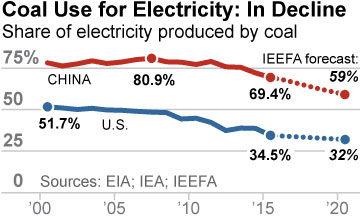The Global Energy Transition Continues

This has been a remarkable year in energy markets across the U.S. and around the world. Change has unfolded fast, and dramatically. The coal industry is in deep structural decline in 2015, oil and gas prices have plunged, the cost of renewable energy has dropped, and China and India—the most populous countries in the world—are making energy-policy choices today they might not have considered a year or two ago, driven by crippling air pollution from coal-fired power.
IEEFA documented many of these market-shifting trends in our year-end report, “Carpe Diem: Eight Signs that Now Is the Time to Invest in the Global Energy Market Transformation,” but that’s not the half of it. We see much more on the horizon. The global emissions-control pact signed in Paris was in part made possible by these changing market forces.
Change doesn’t always come easy, though, and energy markets have long proven especially resistant to transformation. Entrenched interests are threatened by the rise of renewables, and many technological challenges remain. Public-policy battles loom. Much is needed still in the way of innovation that can help communities and workers most affected by fast-moving markets.
Utilities everywhere face important choices on what energy sources to develop and which electricity-delivery systems to support. Regulators are tasked perhaps more than ever with protecting ratepayers from long-term fossil-fuel subsidies. Influencers of all stripes—pension-fund managers, investment bankers, rule-makers, legislators, and elected officials—are presented with previously unheard-of opportunities to support renewable power and energy efficiency.
In our mission to accelerate the transition to the new energy economy, IEEFA specializes in financial and economic analysis that sheds light on energy-market activity around the world. Our work occurs on the front lines. Our research in 2015 informed and influenced debate and decision-making across the U.S.
- We opposed destructive proposals to force consumers to guarantee profits for uncompetitive coal-fired power plants in bailout schemes promoted by FirstEnergy and AEP in Ohio and West Virginia.
- We continued to urge the prudent closure of costly and aging coal-fired electricity plants, making site-specific cases against the Colstrip Generating Station in Montana, Plant Hammond in Georgia, and the C.D. McIntosh Power Plant in Florida.
- We documented the soaring costs to ratepayers and the cautionary tales embodied in the handful of new coal-fired power plants that have come online in the past few years, at Prairie State Energy Campus in Missouri, at the Kemper Project in Mississippi and at the Edwardsport Power Station in Indiana.
- We published research urging Puerto Rico, whose electric system is 95 percent dependent on fossil fuels and is struggling to shoulder high electric rates and high public-utility debt, to invest instead in renewable power and energy efficiency.
- We showed how nuclear-energy giant Exelon’s proposed takeover of Pepco Energy would end up hurting ratepayers in Washington, D.C., and how it would undermine community plans there for a renewable-energy future.
We also tracked the collapse of the U.S. coal industry in 2015, a year in which coal producers lost 76 of their share value and coal companies suffered deep financial distress—bankruptcy in some cases. Our work in this realm raised questions that responsible policymakers today are beginning to answer.
- Whether the federal government, which owns the country’s greatest and most productive coal reserves in the Powder River Basin of Montana and Wyoming, will close royalty loopholes on coal sold for export from that region and whether it will establish true fair market value for those reserves.
- Whether states will properly require coal companies to pay for mine cleanup and reclamation rather than forcing such burdens onto taxpayers.
- Whether publicly subsidized export terminals and new mines will be built.
- Whether the federal government will fulfill its responsibilities, especially in Appalachia, to coal-mining communities struggling to chart a new economic course.
IEEFA has taken the lead in 2015, too, on research that supports choices that can help solve energy poverty in several developing nations. Our work this year in Asia and Europe has offered several guideposts that help show the way.
- On how India’s electricity sector can be transformed by renewable energy.
- On how a plan in Australia to build the biggest new coal mine coal mind in the world is unbankable.
- On how institutional investors like the Norwegian Government Pension Fund can help their bottom lines by divesting from coal.
- On how the World Bank and other international financial institutions can invest prudently in renewables and energy efficiency rather than supporting suspect coal-fired power projects like one being promoted in Kosovo.
As we ring in 2016—sure to be another watershed year—IEEFA aims to expand its work across the new energy economy, where transition is gaining momentum and where the possibilities are vast.
More change is on the way.
Sandy Buchanan is IEEFA’s executive director.
















